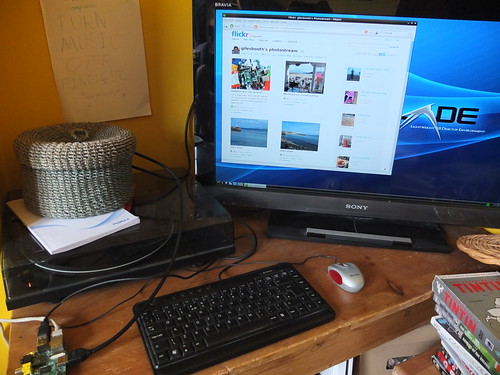
I had joked that the Raspberry Pi was indeed taking me back to the glory days of 1980s computing – mainly by making me wait so long; it reminded me of the interminable delays waiting for Sinclair to ship my ZX Spectrum by mail order.
Today it arrived, and I had almost forgotten why I wanted it in the first place. Here are a few initial reactions and observations:
- A Kindle charger makes a perfect power supply. You need something with a micro USB plug. Mini USB won’t work.
- It’s a very long way from being a finished product – certainly not for the ‘consumer’ and probably not for an education market yet either.
- It’s not for the faint-hearted. At the moment I’d say not to get one unless you have at least some experience of Linux. I have a bit of Linux experience and it took me half a day to get it working.
- Wired (ethernet) internet is very handy, assuming you have the model B. The RasPi has no internal clock, for one thing, and the internet helps it know what millenium it is.
- Making the SD card with the operating system is a bit of a pig if, like me, you only have Macs and WindowsXP – most of the tools seem to be written for Windows7 and Linux.
- If you have a Mac, use RasPiWrite from www.exaviorn.com to make your SD card OS. A 4 GB one seemed big enough. [SEE NEW WARNING IN COMMENTS BELOW]
- DO NOT (at the time of writing) INSTALL FEDORA REMIX AS YOUR OS. I wasted hours on this. It was buggy beyond belief – forced me to change my password to something stupidly complex and then refused to let me log in. I never got past the login screen.
- Install Debian ‘Squeeze’ as your OS instead. This is option 1 in RasPiWrite.
- When you log in at the command line, you need to type startx to get the graphical user interface (windowed desktop) running. This isn’t at all obvious if you’ve never dicked around with Linux before.
- I don’t think sound works on this default distro yet, and there’s not much software with it. There’s a simple web browser and not much else. I easily managed to find MP3 files on my network (on a USB stick in my router) – but the supplied MP3 player couldn’t produce any audio.
- I couldn’t see a simple software / package installer for adding software. This is not Ubuntu. As I say, it’s all a bit hard-core nerdy Linux stuff. There is Python and possibly some other tools for programming but nothing terribly friendly-looking.
- It’s quite slow – but nowhere near as slow as I’d expect a $25 computer to be, and it was driving a 1920 x 1080 display!
- It’s still very early days for Raspberry Pi. Once people start making packages with more fluffy OSs (and perhaps even selling ready-made SD cards tailored to particular uses) this tiny computer will really start to change the world.




UPDATE: The Mac script for making SD card disks RasPiWrite downloads an out-of-date version of the Debian Squeeze image, and there is a bug in it which means it WILL NOT let you use your own disk image. Wasted ages on this – frustrating.